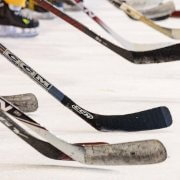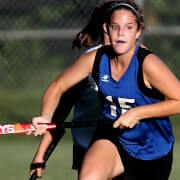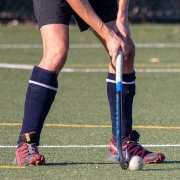-
September 2020
How Long is a Junior Hockey Stick? This Long!

Determining the correct length for a junior hockey stick is an essential component for juniors to get the most out of their game. Though juniors can adapt to different length sticks, finding the right length ensures they are playing as naturally as possible. So, how long is a junior hockey stick?
A junior hockey stick is 50” – 54” long and corresponds typically to those aged 7-13. You want to ensure that your blade’s center is flat on the ground when in skates. Also, If you stand the stick straight up on its toe and the handle reaches between your chin and nose, it’s the correct length.
NAHL vs. USHL: Which League Is Better?

Players with ambitions to play college or professional hockey are usually required to play junior hockey. In America, players can play in the Tier I league, the United States Hockey League, or Tier II, the North American Hockey League. But which league is better?
The USHL is considered better due to being a Tier I league that recruits many players who move on to Division I colleges and the NHL. Players in Tier I or II do not get paid to play but are often recruited by top colleges. However, the chances of recruitment are higher for the USHL than the NAHL.
Top 10 Bauer Youth Skates Reviewed: Which Are Best?

One of the most critical pieces of gear that any youth hockey player needs to get right is the skates that they wear during play. Having the wrong pair can mean painful practices and games, as described in our why are skates so uncomfortable article. Knowing what skates to pick is essential, and Bauer is a great brand to consider.
The ten best Bauer youth skates should increase performance and bring comfort to any youth player. The hot Supreme Ultrasonic pair have been spotted around the NHL and is looking to be skates of the year. They feature a complete redo, including the Quad profile, Unibody sole, and titanium coated blades.
How to Get Noticed at Hockey Tryouts: A Quick Guide

It can be hard sometimes to get noticed by coaches at hockey tryouts. They’re evaluating several players all at once, so you really have to give your all to stand out.
Be prepared. You have to know what’s expected of you: what kind of equipment you need, when to show up, etc. Also, be confident and hard-working. Show that you play hard, skate hard, and move to the front in drills when you can. These are things you can do at hockey tryouts that will get you noticed.
Why Is Field Hockey so Popular in other Countries?

Similar to how soccer is referred to as football in certain parts of the world, making the distinction between ice hockey and field hockey is important as well, depending on where in the world you are.
Field hockey is a popular sport because so many ancient cultures across the world had a sport resembling field hockey, leading to its rapid adoption. In modern times, it is a fast-paced and technical sport that is exciting to watch. Players can compete internationally in places such as at the Olympics.
How Long Do Field Hockey Sticks Last?

Field hockey sticks are unique to the players who use them. They are different lengths and weights, as suited to the size and position of the player. Field hockey sticks are made of various materials, including wood, fiberglass, graphite, carbon, and even kevlar.
Defenders and goalies can typically expect a stick to endure for four to five years. Strikers, forwards, and midfielders can expect more extensive wear, though a well-wrapped stick should last for two to three years of constant play. The type of use will really determine how long the field hockey stick actually lasts.
What is the Hardest Position in Field Hockey?

An amazingly fast game in which the ball can change ends of the 100-yard field in seconds, engaging 22 players in rapidly shifting locations, a frequently asked question is, which is the most difficult position?
While each position is challenging, that of the midfielder or halfback is likely the most difficult. Like those playing striker, the midfielder must be able to challenge the opposition goal and score. The midfielder must also be able to defend and, above all, the midfielder runs continually, requiring superb stamina.
Can You Use Both Sides of a Field Hockey Stick?

Sports games come in all varieties, and some even have notable variations involved. One of the most famous examples of this is that of hockey and the differences between the ice and field versions.
Unlike ice hockey, you cannot legally use both sides of the stick in field hockey. One side of the stick is flat, which you can use for regular play, while the other side is deliberately curved and may not be used for contacting the ball at all. There are also other notable differences between field hockey and ice hockey.
How Early Should You Get to a Hockey Game?

If it is your first time attending a hockey game, it may be a little difficult to pin down exactly what to expect. One of the primary questions fans ponder prior to arrival is just how soon they should show up to the arena. On the one hand, you do not want to show up hours early and be left sitting in the parking lot; on the other; you might be scared to death of missing some of the opening action.
In general, it is best to get to a hockey game about an hour before the puck is scheduled to drop. This will give you plenty of time to find the arena, secure a parking spot, locate your seats, and enjoy any of the numerous pre-game activities.
Which Age Is Best to Start Ice Hockey? Our Thoughts

Typically, ice hockey players are children to young adults. It was once thought that children should be started as early as possible to become successful in ice hockey, but that is no longer the case. In fact, some professionals discourage early specialized play of the sports as it increases the risk of injury, which may cut the player’s career short.
We think that the best age to start playing ice hockey is when the player gets excited about playing ice hockey. Whether that age is five or fifty, they’ll be much better at playing the sport if you are excited about playing it. While children are not allowed to play on a team before the age of five, they can begin learning the skills for the game earlier or later than that age.